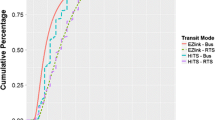Abstract
Automatic fare collection (AFC) system archives massive and continuous trip information for each cardholder. Mining the smart card transaction data from AFC system brings new opportunities for travel behavior and demand modeling. This study focuses on detecting the home location and trip purposes for subway passengers (cardholders), based on the internal temporal–spatial relationship within multi-day smart card transaction data. A center-point based algorithm is proposed to infer the home location for each cardholder. In addition, a rule-based approach using the individual properties (home location and card type) of cardholders and the travel information (time and space) of each trip is established for trip purpose identification. The smart card data from Beijing subway in China is used to validate the effectiveness of the proposed approaches. Results show that 88.7% of passengers’ home locations and four types of trip purposes (six subtypes) can be detected effectively by mining the card transaction data in one week. The city-wide home location distribution of Beijing subway passengers, and travel behavior with different trip purposes are analyzed. This study provides us a novel and low-cost way for travel behavior and demand research.

















Similar content being viewed by others
References
Agard, B., Morency, C., Trépanier, M.: Mining public transport user behavior from smart card data. In: 12th IFAC Symposium on Information Control Problems in Manufacturing-INCOM. 17–19 (2006)
Ahas, R., Silm, S., Järv, O., Saluveer, E., Tiru, M.: Using mobile positioning data to model locations meaningful to users of mobile phones. J. Urban Technol. 17(1), 3–27 (2010)
Bagchi, M., White, P.R.: The potential of public transport smart card data. Transp. Policy 12(5), 464–474 (2005)
Barry, J., Freimer, R., Slavin, H.: Use of entry-only automatic fare collection data to estimate linked transit trips in New York City. Transp. Res. Record J. Transp. Res. Board 2112, 53–61 (2009)
Barry, J., Newhouser, R., Rahbee, A., Sayeda, S.: Origin and destination estimation in New York City with automated fare system data. Transp. Res. Record J. Transp. Res. Board 1817, 183–187 (2002)
Beijing Transportation Research Center: Beijing Transportation Smart Card Usage Survey. Research Report (2010)
Beijing Transportation Research Center: Beijing transport annual report in 2015. http://www.bjtrc.org.cn/JGJS.aspx?id=5.2&Menu=GZCG (2016). Accessed 11 Aug 2016
Beijing Transportation Research Center: report on Beijing Traffic Operation in 2015. http://www.bjtrc.org.cn/JGJS.aspx?id=5.3&Menu=GZCG (2016). Accessed 7 Jun 2016
Chakirov, A., Erath, A.: Activity identification and primary location modelling based on smart card payment data for public transport. In: The 13th International Conference on Travel Behavior Research (2012). doi:10.3929/ethz-a-007328823
Chapleau, R., Trépanier, M., Chu, K.K.: The ultimate survey for transit planning: complete information with smart card data and GIS. In: Proceedings of the 8th International Conference on Survey Methods in Transport: Harmonisation and Data Comparability, pp. 25–31 (2008)
Dash, M., Nguyen, H.L., Hong, C., et al.: Home and work place prediction for urban planning using mobile network data. In: 2014 IEEE 15th International Conference on Mobile Data Management (MDM), vol. 2, pp. 37–42 (2014)
Devillaine, F., Munizaga, M., Trépanier, M.: Detection of activities of public transport users by analyzing smart card data. Transp. Res. Record J. Transp. Res. Board 2276, 48–55 (2012)
Han, G., Sohn, K.: Activity imputation for trip-chains elicited from smart-card data using a continuous hidden Markov model. Transport. Res. B-Meth. 83:121–135 (2016)
Hasan, S., Schneider, C.M., Ukkusuri, S.V., et al.: Spatiotemporal patterns of urban human mobility. J. Stat. Phys. 151(1–2), 304–318 (2013)
Hurtubia, R., Flotterod, G., Bierlaire, M.: Inferring the activities of smartphone users from context measurements using Bayesian inference and random utility models. In: European Transport Conference (2009)
Jiang, S., Fiore, G.A., Yang, Y., et al.: A review of urban computing for mobile phone traces: current methods, challenges and opportunities. In: Proceedings of the 2nd ACM SIGKDD International Workshop on Urban Computing (2013)
Kitamura, R., Chen, C., Narayanan, R.: Traveler destination choice behavior: effects of time of day, activity duration, and home location. Transp. Res. Record J. Transp. Res. Board 1645, 76–81 (1998)
Lee, S.G., Hickman, M.: Trip purpose inference using automated fare collection data. Public Transp. 6(1–2), 1–20 (2014)
Lee, S., Hickman, M.D.: Travel pattern analysis using smart card data of regular users. In: Transportation Research Board 90th Annual Meeting. Washington (2011)
Li, G., Yu, L., Ng, W. S., et al.: predicting home and work locations using public transport smart card data by spectral analysis. In: 2015 IEEE 18th International Conference on Intelligent Transportation Systems, pp. 2788–2793 (2015)
McGowen, P., McNally, M.: Evaluating the potential to predict activity types from GPS and GIS data. In: Transportation Research Board 86th Annual Meeting, Washington (2007)
Moiseeva, A., Jessurun, J., Timmermans, H.: Semiautomatic imputation of activity travel diaries: use of global positioning system traces, prompted recall, and context-sensitive learning algorithms. Transp. Res. Record J. Transp. Res. Board 2183, 60–68 (2010)
Morency, C., Trepanier, M., Agard, B.: Measuring transit use variability with smart-card data. Transp. Policy 14(3), 193–203 (2007)
Munizaga, M.A., Palma, C.: Estimation of a disaggregate multimodal public transport Origin–Destination matrix from passive smartcard data from Santiago, Chile. Transp. Res. Part C Emerg. Technol. 24, 9–18 (2012)
Pelletier, M., Trépanier, M., Morency, C.: Smart card data use in public transit: a literature review. Transp. Res. Part C Emerg. Technol. 19(4), 557–568 (2011)
Reddy, A., Lu, A., Kumar, S., Bashmakov, V., Rudenko, S.: Entry-only automated fare-collection system data used to infer ridership, rider destinations, unlinked trips, and passenger miles. Transp. Res. Record J. Transp. Res. Board 2110, 128–136 (2009)
Reumers, S., Liu, F., Janssens, D., Cools, M., Wets, G.: Semantic annotation of global positioning system traces: activity type inference. Transp. Res. Record J. Transp. Res. Board 2383, 35–43 (2013)
Seaborn, C., Attanucci, J., Wilson, N.: Analyzing multimodal public transport journeys in London with smart card fare payment data. Transp. Res. Record J. Transp. Res. Board 2121, 55–62 (2009)
Stopher, P., FitzGerald, C., Zhang, J.: Search for a global positioning system device to measure person travel. Transp. Res. Part C Emerg. Technol. 16(3), 350–369 (2008)
Trépanier, M., Tranchant, N., Chapleau, R.: Individual trip destination estimation in a transit smart card automated fare collection system. J. Intell. Transp. Syst. 11(1), 1–14 (2007)
Widhalm, P., Yang, Y., Ulm, M., Athavale, S., González, M.C.: Discovering urban activity patterns in cell phone data. Transportation 42(4), 597–623 (2015)
Wolf, J., Guensler, R., Bachman, W.: Elimination of the travel diary: experiment to derive trip purpose from global positioning system travel data. Transp. Res. Record J. Transp. Res. Board 1768, 125–134 (2001)
Yan, Z., Chakraborty, D., Parent, C., et al.: SeMiTri: a framework for semantic annotation of heterogeneous trajectories. In: Proceedings of the 14th International Conference on Extending Database Technology, pp. 259–270 (2011)
Zhao, J., Rahbee, A., Wilson, N.H.M.: Estimating a rail passenger trip Origin–Destination matrix using automatic data collection systems. Comput. Aided Civ. Infrastruct. Eng. 22(5), 376–387 (2007)
Zhang, F., Yuan, N.J., Wang, Y., et al.: Reconstructing individual mobility from smart card transactions: a collaborative space alignment approach. Knowl. Inf. Syst. 44(2), 299–323 (2015)
Acknowledgement
The authors would like to acknowledge the Beijing Municipal Commission of Transport for data support. This research is supported by the Project of Fundamental Research Funds for the Central Universities (2016JBM024), National Natural Science Foundation of China (51478036), and the China Postdoctoral Science Foundation (2016M591062).
Author information
Authors and Affiliations
Corresponding author
Rights and permissions
About this article
Cite this article
Zou, Q., Yao, X., Zhao, P. et al. Detecting home location and trip purposes for cardholders by mining smart card transaction data in Beijing subway. Transportation 45, 919–944 (2018). https://doi.org/10.1007/s11116-016-9756-9
Published:
Issue Date:
DOI: https://doi.org/10.1007/s11116-016-9756-9




